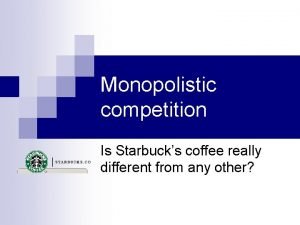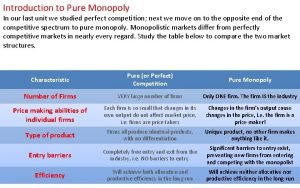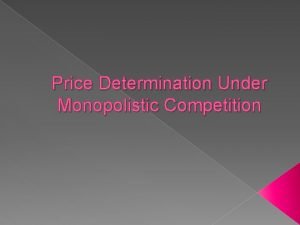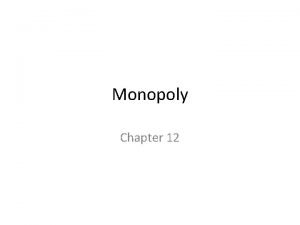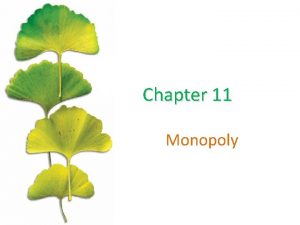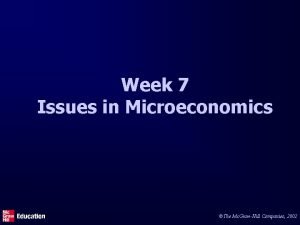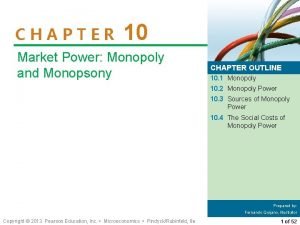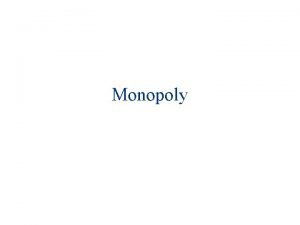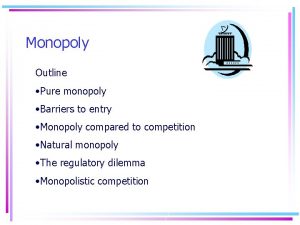Intro to Monopoly Mr OGrady Intro to Monopoly









- Slides: 9

Intro to Monopoly Mr O’Grady

Intro to Monopoly Definition: A monopoly is defined as a market with a single seller of a good or service Under this definition, we assume that a monopoly possesses 100% market share. However, pure monopolies are actually very rare (how many firms do you know with absolutely no competitors? ). Accordingly, the legal definition of a monopoly is a firm which holds a market share of 25% or more – the focus is therefore on whether a firm has enough market power that it can act independently of its competitors. Assumptions: Single seller, many buyers: The firm has market power as the firm is the sole market supplier Downward sloping D curve – representing demand for both the firm and the market (the sole firm is the market!) Firm is a price-maker No substitutes for the firm’s products: Either actual or potential Buyers must rely on the monopolist only High Barriers to entry: difficult for new firms to enter the market for reasons such as: Legal protection - patents, copyrights, trademarks, trade secrets R&D - a sunk cost which keeps products hi-tech and difficult to imitate Brand loyalty - especially through advertising (a sunk cost) Very high fixed costs - potentially sunk costs Profit maximisation: The monopolist will produce at the level of output where MR = MC Result: The combined result is that the firm is totally insulated from any competition and should therefore make supernormal profits in both the short-run and the long-run

Monopoly Equilibrium Monopoly Mr O’Grady

Monopoly Equilibrium: Not only can firms can make supernormal profits, but they will look to profit maximise (green rectangle). The market price is above the firm’s average cost. C/R MC p. Mon DWL AC c. Mon D = AR q. Mon MR Quantity The sole firm individually produces at the point where MC meets the MR (q), charging price p. Mon at average cost c. Mon Allocatively inefficient (P > MC) and Productively inefficient (c > AC min) There is a deadweight loss present for a profit maximising monopoly! Total welfare is not maximised.

Dynamic Efficiency: Supernormal profits allow the monopolist to spend money on R&D and on innovations There may be a faster rate of technological development that will reduce costs and produce better quality items for consumers Dynamic Efficiency! However: for firms to innovate, they must be assured that they will be the ones to profit from their research They need patents that provide legal protection of an idea or process and prevent other firms from duplicating their work and taking some of the industry’s profit Otherwise there will be limited R&D and dynamic efficiency X-inefficiency: if a monopolist isn’t threatened by new entrants, they will have little incentive to control their costs Their profits aren’t at risk so why there is only limited gain to working hard to keep costs low Organizational slack occurs as the firm can hide behind barriers to entry and is insulated to competition. Also there are links to divorce between ownership and control. Non profit maximising behaviour of workers may also increase costs e. g. CEO flying on a corporate jet However: if a monopolist thinks their will be greater competition in future they will seek to keep their costs from growing, so as to be in a stronger position to fight

Types of Monopoly Mr O’Grady

Types of Monopoly Legal Monopoly (I) – permanent: A continuous monopoly protected by law Usually having been created by the Gvt E. g. Royal Mail prior to privatisation Illegal for any other firm to deliver packages weighing <350 g or charging <£ 1 for postage But in 2006 Royal Mail has lost its government protected monopoly Legal Monopoly (II) – temporary: where firms have temporary barriers to entry that protect their monopoly power Often created by Intellectual property rights (IPRs): Patents, Copyrights & Trademarks Gives the owner of the IPR a temporary monopoly over their particular invention, idea or design E. g. Pharmaceutical products or technology (Apple vs Samsung) Local Monopoly: Where there is no practical alternative to using the available supplier E. g. Ben & Jerry’s at the cinema, Canteen and vending machines at school, etc Competitive Monopoly: Where a monopoly has arisen from a firm’s own actions E. g. Microsoft – anticompetitive practices following differentiated products (Windows)

Natural Monopoly: Where the economies of scale are so great there is only room for one supplier in the market: C/R p. NMon c. NMon q. NMon MR AC MC AR Quantity Very high Fixed costs that are usually sunk costs too. This means AC falls continuously with output. Negligible MC which also falls continuously with output but more importantly, MC is always below the AC curve for any realistic level of output A second firm in the industry would mean: An unnecessary duplication of FC and a Loss of scale economies for both firms This would mean higher AC than is necessary, and high prices for the consumer Hence removing a natural monopoly is worse for society than letting the monopoly exist

Where next? Visit our website: www. smootheconomics. co. uk Find more resources, enrichment materials, details of courses, competitions, and more! Find Our socials: You. Tube: Smooth Economics Instagram: @smootheconomics Twitter: @Smooth. Economics Facebook: @Smooth. Economics
